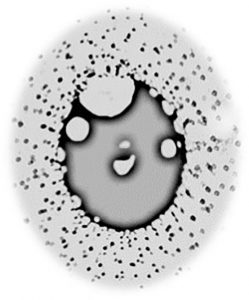Where did the tin go? Mass loss from a thin sheet of tin
“We were amazed that we could see light shine through a sheet of liquid tin”, says group leader Oscar Versolato. The EUV Plasma Processes group at ARCNL studies tin microdroplets that become a hot and dense plasma, emitting EUV light for state-of-the-art nanolithography. In the process of creating such a plasma, a tin droplet is hit by an energetic laser pulse and deforms into an ultrathin sheet. PhD student Bo Liu developed two methods to measure the thickness of these tin sheets and determine their mass loss. In collaboration with researchers from Eindhoven University of Technology and ASML, they published their results on 13 February 2020 in Physical Review Applied.

To produce ever smaller features on chips for computers, smartphones, and many other electronic devices, the latest generation of lithography machines use EUV light, because its short wavelength makes it possible to print extremely small patterns. However, ‘using EUV light’ is not as straightforward as it may sound. It requires heating a drop of fluid to the point where the material disintegrates into independent electrons and atomic nuclei (ions), to become a so-called plasma that is very hot (over 1 MK) and emits EUV light.
Deforming tin droplets
State-of-the-art lithography machines typically use very small tin droplets and apply laser pulses to create an EUV-emitting plasma. This happens in two stages. A laser pre-pulse hits the droplet and causes it to accelerate and deform. After that, a second, more powerful main laser pulse turns the deformed droplet into an EUV-emitting plasma.
To get a more fundamental understanding of what happens when these tin droplets deform and turn into a plasma, Versolato collaborates closely with Dmitry Kurilovich (ASML) and Hanneke Gelderblom (TU/e researcher in the field of fluid physics). “We study droplet deformation in detail”, he says. “Typically, a pre-pulse deforms the droplets into thin sheets that look like pancakes with a spray of microparticles around it, which we can clearly see in our experiments. We make shadowgraph images, where we light the sheets from behind and take a picture. When we digitally enhanced the contrast of these images, we were shocked to find out that the tin sheets actually let through some of the imaging light. They were much thinner than we thought.”
Massive mass loss
Where did the tin go, if it was not in the pancake? PhD student Bo Liu set out to determine the thickness of the tin sheets using two independent methods. “First, he measured the transmission of light through an expanding sheet of tin in shadowgraph images, at different points in time. With this data, we were able to calculate the sheet thickness using the refractive index of tin”, says Versolato.
Eventually, the expanding sheets get so thin, that holes appear. For his second approach, Liu measured the growth of the holes by taking a second shadowgraph image of the same sheet. However, now he used a time delay of 150 nanoseconds. This time, he used the density and surface tension of the material to calculate sheet thickness from the data.
Although the methods are completely independent, they were in excellent agreement. Versolato: “We combined the results of these two methods in a model that predicts sheet thickness at any point in time, for arbitrary starting conditions. It turned out that under the conditions relevant for nanolithography, less than half of the original mass of the tin droplets remains in the pancake sheet. Our theoretical analysis shows that most of the mass that leaves the sheet upon expansion ends up in the spray of fragmented droplets around the sheet.”
Timing is crucial
This ‘hairy’ rim of fragmented tin may look nice in pictures, but it potentially reduces the lifetime of an industrial machine, because the fragments can fly away and settle on optical elements nearby as debris. Also, the fragmented micro-particles around the sheet may not get hit by the main laser pulse that should turn the tin into EUV emitting plasma.
“We found that the amount of tin in the rim is dependent on time only. In other words, the sooner the main pulse is fired at a sheet of tin, the more tin will remain in the sheet and be turned into plasma”, Versolato explains. “To make sure the sheet has expanded enough in such a short time interval, a pre-pulse with higher energy is needed to increase expansion speed. These changes may enhance the effectiveness of EUV light production in industrial settings, by both minimizing debris and optimizing the amount of tin needed to create EUV light.”
Reference
Mass Loss from a Stretching Semitransparent Sheet of Liquid Tin, Bo Liu, Dmitry Kurilovich, Hanneke Gelderblom, and Oscar O. Versolato, Phys. Rev. Applied 13, 024035 – Published 13 February 2020








